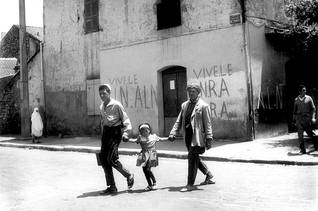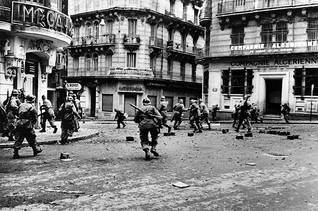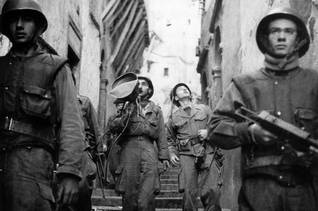
In 1954 the National Liberation Front (Front de Libération Nationale, FLN) began an armed campaign against the French authorities. At the time, it was hard to see how the series of small-scale attacks on the powerful French army and the colonial infrastructure could lead to an all-out war that lasted for eight years and ended with the departure of the colons.
In the first years, there were also battles between the FLN and the partisans of Messali Hadj. This was exemplified by the killing, in 1957, of more than three hundred inhabitants of the village of Melouza, deemed supporters of Messali, by the FLN. Militarily, the guerrilla fighters were no match for the French army. Through the massive deployment of force and the widespread use of torture, the French largely put down the urban guerrillas in the 1957 Battle of Algiers.
The rural areas in the interior were subjected to napalm bombings, while the borders with Tunisia and Morocco were heavily guarded to prevent FLN incursions. But it was too late for a return to the colonial status quo. Algerian nationalism had become a cause for the masses to rally behind, while the colonists were terrified by bomb attacks and other elements of war that disrupted their way of life and produced a continuous fear for the future. Internal divisions and international pressure worked against Paris during a time of worldwide decolonization.
Under the presidency of General Charles De Gaulle, from 1958 onwards, France slowly began changing course. The new President regarded the war as unwinnable, while it became clear that France had less to gain from holding on to its overseas agricultural possessions than from transforming itself into an industrial nation.
De Gaulle opted for a solution that would leave France with some influence in Algeria but in fact meant the end of the colonial status quo. During the first contacts, he tried to keep the Sahara for France, because of the discovery of oil and the perceived need to test nuclear weapons at Reggane. For most colons and many other segments of French society, this was not acceptable, as the ‘loss’ of Algeria would, in fact, mean the end of the French empire.
In response, extremist elements in the French army, forming the Organization of the Secret Army (Organisation de l’Armée Secrète, OAS), began a terrorist campaign and even targeted De Gaulle. This led to further bloodshed but did not change the course of history.
It is estimated that between 400,000 and 1,500,000 Algerians were killed during the war of liberation (1954-1962), usually called the Algerian War of Independence or the Algerian Revolution. The number of dead have always been a source of contention: French historians put the number at around 300,000, but it is not always clear whether this includes the many wounded who, after 1962, succumbed to their injuries or those who were made to ‘disappear’. The higher figures of more than one million are part of the official Algerian discourse on the war.






